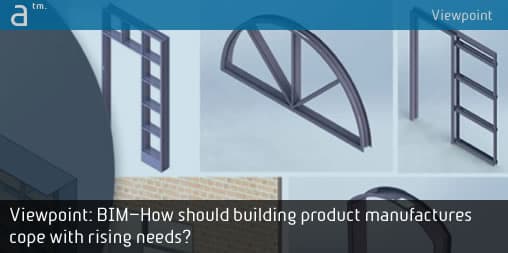Although half the leading architects and engineers pine that they do not require BIM for all of their specified building products, they aren’t completely right. Upon a discussion with an architect or an MEP or structural engineer, one might realize that creating mere 3D models of building products might help them in preparing BIM models for a prospect, but there will be numerous challenges while deciding spatial arrangements.
The reason for the differed view of AEC industry professionals about the need for BIM objects is the fact that we are still learning the attributes in BIM. AEC professionals have a varying perception about BIM, and they use it as they please. Such changing perceptions are sending out mixed messages to building product manufacturers putting them in a dilemma of sorts.
PDT or BIM objects?
Amidst this dilemma and mixed signals, collaborating with building products manufacturers becomes even more difficult. A large percentage of architects and structural engineers prefer to develop their own library of BIM objects for structural elements and ornamental architectural products. BIM objects prepared or received directly from the manufacturer are easily replicated quickly for as-built models, while the remaining design consultants—comprising of architects and structural engineers—do not need all BIM objects, but just the geometric specifications. Based on this data, they develop their own BIM geometry and use it for spatial arrangement and design insights. In this case, product data templates do fine. Comprehensive PDTs adhering to Industry Foundation Classes [IFC], COBie, etc. will serve this role perfectly well.
MORE: BIMscript and LENA by BIMobject of Sweden
It thus is a matter of choosing which one to adopt, but either way, manufacturers need to deliver their products, design models for which can be directly used by contractors or building design consultants. It will facilitate avoiding any variance in decision-making by any of the design stakeholders.
More Challenges with the Dilemma
Because the AEC industry has a diversified perception to BIM, manufacturers are in a dilemma whether to deliver BIM objects or just PDTs. It also puts them in a situation where it becomes a hurdle in selecting the correct place to host their manufactured product’s BIM data. Ideally, the place should be their website, but since AEC design professionals are reluctant in registering there for their own purposes, it is not a very good option.
As an alternative, what manufacturers need to do is transform their data into smart data that can easily be searched and understood by anyone across the supply chain. Additionally, if geometrical data adheres to industry accepted standards, chances are less that it is inconsistent with BIM models and eliminates data duplication. Another advantage of using standardized data is that it is interoperable across external CAD, BIM, and database platforms. It means that manufacturers’ model can easily be accessed on CAD platforms fondly used by architects or engineers without loss of information.
Will Manufacturers Benefit From This?
When contractors are on the run to drag-in BIM at every stage of building construction projects, it is apparent that manufacturers will need to adopt such a strategy as outlined above sooner or later. But the benefits [and cons] of adopting BIM [or not adopting] start immediately.
BIM can help building products manufactures specify their product with a sharper degree of detail. For instance, every dimension, curve, joint, et cetera can be communicated efficiently. The need for BIM content comes in very handy in the case of plant room construction, wherein every object placed is interconnected, and is critical.
Also when the AEC professionals know the products more clearly, it indeed is easier for them to select one that suits the building the best. The same applies to procurement and logistics division as well. They can buy the products from manufacturers with more clarity and confidence resulting in long lasting customer relationships.
Thankfully with the advancements in technology, these products that are procured can also be tracked for details like who purchased it, its installation, operations, and maintenance. The customer (end user client) feedback can also be received by the manufacturer through the same channel, and hence it will essentially help them upgrade their products’ qualities. With connected sensor technology in the era of IoT (Internet of Things), this isn’t a fantasy but the real horizon of where AEC technologies are going and the benefits they will bring to the building industry.
What manufacturers need to do is overcome the BIM direction dilemmas they face and make their BIM content—along with the building products data—more BIM-friendly. The fact is contractors are embracing BIM wholeheartedly, and if product manufacturers are not embracing BIM as well eventually, they will be forced into responding to the challenges outlined above instead of driving at and being apart of the solutions for the whole industry.
About the Author
Hiral Patel is a news editor at Hi-Tech CADD Services and has been contributing to the AEC industry for the last 7 years. She mainly writes about the application of BIM across Architecture, MEP, and Structural sectors. Her focus is towards encouraging construction companies, sub-contractors, and architects to adopt the right technologies to improve efficiency and profitability.
